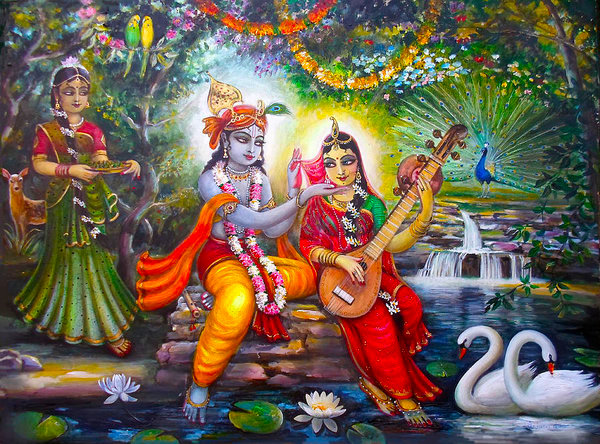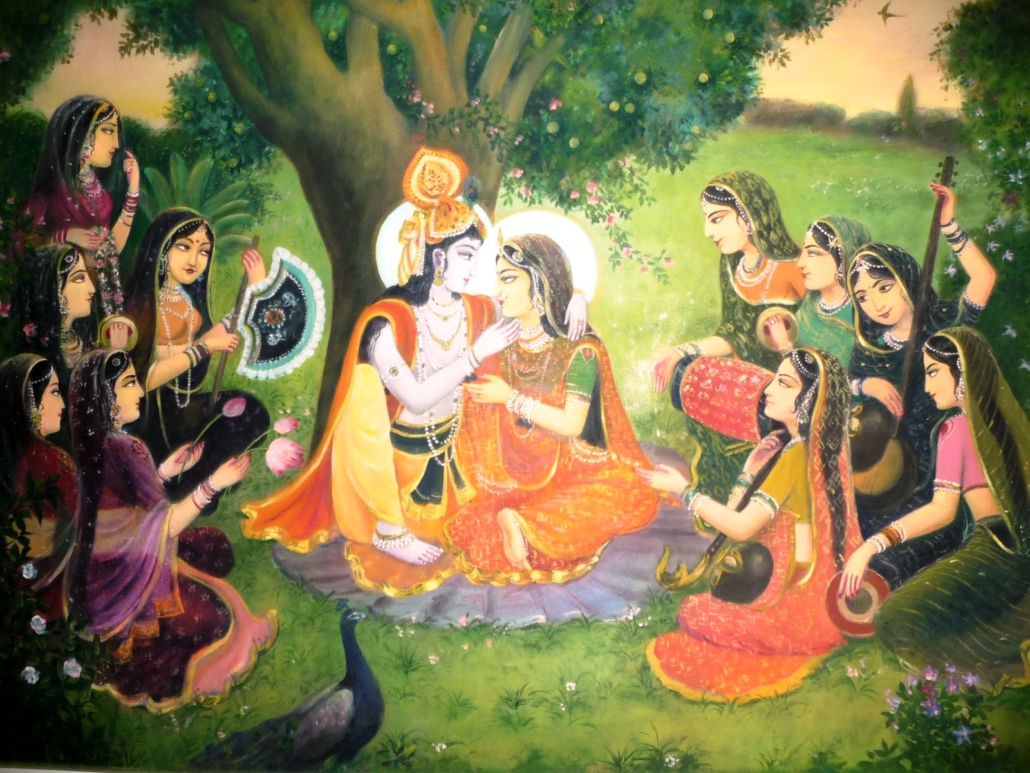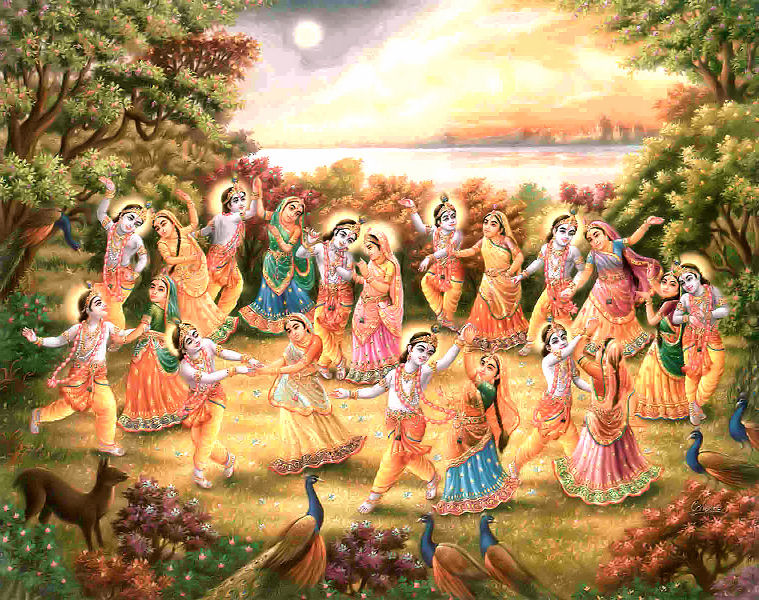Mahanidhi Swami
Sri Caitanya Mahaprabhu personally taught sadhana bhakti and its two divisions, vaidhi and raganuga, to his chief followers Sri Ramananda Raya, Sri Sanatana Goswami and Sri Rupa Goswamipada.
Raganuga-bhakti means having a fervent desire and attraction to follow the feelings and sevas of a particular eternal Vrajavasi associate of Sri Krishna, who personifies the foundational loving relationship i.e. sthayi-rati, that you want to eternally have with Bhagavan Sri Krishna. For example, if you desire to love and serve Krishna as His household servant i.e. dasya-rati, you’ll emulate and Raktaka, Patraka etc.
Desiring friendship i.e. sakhya-rati (becoming a cowherd boy) with Krishna means to follow the moods and ways of Subala, Sridama, etc. For a parental relationship i.e. vatsalya-rati, your ideals are Nanda Baba and Yasoda Ma; and if you hanker for Krishna’s seva in amorous love i.e. srngara madhurya-rati, you will practice raganuga-bhakti in allegiance to Srimati Radharani, Lalita, Visakha, Sri Rupa or Tulasi manjari.
So you can see that there are four paths of raganuga-bhakti leading either to dasya, sakhya, vatsalya or madhurya ratis in Vrndavana.
FACT ONE:
However, the most startling and significant FACT IS that Sri Caitanya Mahaprabhu Himself, the Six Goswamis, Sri Narottama Dasa Thakura, and Sri Visvanatha Cakravarti, and all the Gaudiya Vaisnava acaryas ONLY TAUGHT AND WROTE specifically about practicing raganuga-bhakti sadhana TO BECOME A SAKHI/MANJARI in srngara madhurya-rati to eternally serve Radha-Krishna in the kunjas of Vrndavana!
Therefore, as a Gaudiya Vaisnava where is the scope for anything else like becoming a cowherd boy, parent or servant in Vraja? Where will you find the sastras, the sacred books, the Gurus, the mantras, and the teachings to pursue any other sthayi-rati than srngara madhurya-rati to become a sakhi/manjari dasi maidservant of Sri Sri Radha and Krishna?
The answer is you won’t find help anywhere in the Gaudiya Vaisnava sampradaya.
YOU WILL BE LOST—stranded, alone and wandering without guidance, which is definitely a risky path to tread. Gaudiya Vaisnavism means raganuga-bhakti, and for Sri Caitanya Mahaprabhu, the Six Goswamis and all our acaryas, RAGANUGA BHAKTI MEANS VRAJA GOPI BHAVA AND MADHUYRA RATI!
Sri Caitanya Mahaprabhu Himself directly experienced, relished and taught ONLY ABOUT raganuga-bhakti in srngara madhurya-rati. Mahaprabhu also instructed all His DIRECT FOLLOWERS to do the same. Thus Sri Raya Ramananda, Sri Sanatana Goswami, Sri Rupa Goswamipada, Sri Raghunatha Dasa Goswami and Sri Krishna Dasa Kaviraja wrote extensively about practicing raganuga-bhakti to become a sakhi/manjari of Radha-Govinda Yugala in Vraja.
What is the proof for all these statements? Sri Caitanya Mahaprabhu’s direct words and teachings are the proof that gopi/manjari bhava is the one and only way to attain success and spiritual perfection in Krishna bhakti bhajana.
The following quotations from Sri Caitanya Caritamrta will prove and establish all the truths revealed above. Please carefully read these verses and study them with your teachers. Also read these two chapters in order to fully grasp this subject: Sri Caitanya Caritamrta Adi-lila chapter 4; Madhya-lila chapter 8, and all the later chapters of Antya-lila.
In Sri Caitanya Caritamrta, madhhya-lila, chapter eight (Caitanya Caritamrita 2.8.57-191), Mahaprabhu asks life’s most crucial questions. What is the goal of human life and how to attain it? Mahaprabhu then directly empowers and enlightens Sri Ramananda Raya, who in turn gives the perfect answers, which Mahaprabhu patiently listens to. What follows is a summary of Mahaprabhu’s teachings on what is raganuga-bhakti, how to practice it, what wonderful result does it give the sadhaka?
First Mahaprabhu asks, “What is the way and the means (sadhana) to attain the ultimate goal (sadhya) of human life?
Raya Ramananda answers, “Vishnu bhakti is the goal, and one can perform it by following the rules and duties of one’s position, sva dharma acarane, aka following the varnasrama system.” (Caitanya Caritamrita 2.8.57)
Mahaprabhu replied, “This is external or irrelevant, so go forward and speak more about the means and goal of human life, eho bahya, age kaha ara.”
Raya Ramananda continued each time speaking what he thought was the essential goal of life, sarva-sadhya-sara. (Caitanya Caritamrita 2.8.59) Raya Ramananda then said karma arpana as the goal, and again Mahaprabhu rejected this practice saying speak more, go further.
Raya Ramananda mentioned svadharma tyaga (renouncing one’s sva-dharma); and jnana-misra bhakti (bhakti mixed with brahma jnana and yoga).
Mahaprabhu rejected both saying they are external, speak further.
Then Raya Ramananda said, jnana-sunya bhakti (bhakti free from brahma jnana), and Mahaprabhu said, “This is OK, but go further, speak more.” Raya Ramananda replied by saying Krishna prema bhakti is the goal. Nodding His beautiful golden head in approval, Mahaprabhu said, “Yes this is OK, but go further speak more about this.”
Raya Ramananda: “Dasya prema, serving Sri Krishna as a humble servant.”
“Yes this is OK, but go further and speak more about this said Mahaprabhu.”
Raya Ramananda: “Sakhya prema (serving Krishna like His friends Sridama or Subala), and vatsalya-prema (serving Krishna like Yasoda Ma).” Hearing this, Mahaprabhu smiled in joy saying, “Yes, these are the TOP, but go further, speak more, eho uttama, age kaha ara.”
Raya Ramananda said life’s perfection is kanta Krishna prema (serving Krishna as His transcendental amorous lover like Srimati Radharani and the Vraja-gopis). Then he perfectly defined it in 16 most wonderful verses (Caitanya Caritamrita 2.8.80-95). Hearing his elucidation, Mahaprabhu’s heart swelled and His beautiful lotus faced flushed with bliss as He replied, “Radha’s Krishna kanta prema is certainly the HIGHEST LIMIT OF HUMAN PERFECTION, sadhya avadhi suniscaya. Be merciful and speak a little more, krpa kari kaha age kichu haya.” (Caitanya Caritamrita 2.8.96-97)
After Raya Ramananda mentioned only three verses about Radhika’s exceptional Krishna prema, Mahaprabhu said, “By hearing about Radharani, I feel so happy! Your katha is a rushing river of unprecedented nectar, but speak more, age kaha, sunite pai sukhe, apurv amrta nadi vahe!” (Caitanya Caritamrita 2.8.101)
Raya Ramananda then uttered 18 of the choicest sastric praman verses to describe the matchless pure love of Srimati Radharani. (Cc. 2.8.98-116) Sighing in ultimate satisfaction, Mahaprabhu loudly proclaimed, “Now I have learned the topmost objective of all transcendental wisdom, saba tattva-vastu, haila mora jnana!! And now I understand the ultimate goal of human life and the means to attain it; but say a little more, janilun sadhya sadhana nirnaya, age ara anilun sadhya-sadhana-nirnaya ache kichu.” (Caitanya Caritamrita 2.8.117-118)
Raya Ramananda then expertly and fully explained all about Radha and Krishna’s transcendental forms (svarupa-tattva), rasa-tattva, prema-tattva, and Radha-Krishna prema tattva. However, when he mentioned Radha-Madhava’s prema vilasa varta, a bewildering revolution in divine amorous ecstasy, Mahaprabhu succumbed to prema, and covered Ramananda’s mouth with His hand, preme sva-haste tanra mukha acchadila. (Caitanya Caritamrita 119-193) Sri Caitanya Mahaprabhu ki jai! Radha-Krishna prema ki jai!
Mahaprabhu concluded, “O Raya Ramananda, without practicing raganuga bhakti sadhana this topmost goal of human life, Radha-Krishna prema, will never be attained, sadhya vastu sadhana vinu, keha nahi paya. So please tell Me (and all Gaudiya Vaisnavas) the means to attain, kaha pabara upaya, Radha-Krishna prema?” (Caitanya Caritamrita 2.8.197)
Raya Ramananda said, “Radha-Krishna lila is very deep and confidential. YOU CAN NEVER ATTAIN IT by dasya, sakhya or vatsalya bhava, i.e. being Krishna’s servant, cowherd boy or parent. There is one and only one way to attain the goal of Radha-Krishna’s pastimes and Their seva in the bowers of Vraja. One must adopt gopi-bhava and follow the Vraja-gopis, sakhi bhave kare anugati, radha krishna kunja seva sadhya sei paya, ara nahika upaya!” (Caitanya Caritamrita 2.8.204-205)
Raya Ramananda then spoke 16 amazing verses about the beautiful Vraja gopis. So how to attain all of this? Raya Ramananda answers, “You must worship Radha-Krishna on the path of raganuga-bhakti, raganuga marge bhaje, yei jana.” (Caitanya Caritamrita 2.8.221)
So how to practice raganuga-bhakti? Ramananda answers, “You must accept gopi-bhava, and day and night meditate on the pastimes of Radha and Krishna, ataeva gopi bhava, kari angikara, ratri dina cinte radha krishna vihara. Remember your eternal spiritual body, SIDDHA DEHA, and mentally serve Radha and Krishna. By doing this you will attain the perfection of gopi-bhava and the lotus feet of Radha-Krishna, siddha-dehe cinti kare sevana, sakhi bhave paya radha krishnera caraëa” (Caitanya Caritamrita 2.8.228-229)
After hearing Raya Ramananda’s perfect and complete description about the TOPMOST means and goal of human life, sadhana sadhya sara, Mahaprabhu tightly embraced him and started crying profusely in ecstatic love, eta suni prabhu, kaila alingana, karena krandana. (Caitanya Caritamrita 2.8.233)
Thus concludes the full and clear meaning of exactly what is raganuga-bhakti with all facts and proof from sacred sastra. Jai Jai Sri Radhe! Jai Srila Prabhupada! Jai Gurudeva!



